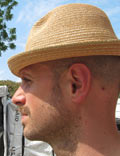Arch Lecture Series features design, academic notables
Luminaries from design world and academia, including Tom De Blasis, global design director for Nike, will headline the Texas A&M Department of Architecture 2011 Fall Lecture Series. The lectures, scheduled below, will be held 5 p.m.in the Preston Geren Auditorium in Building B of the Langford Architecture Center.
 Sep. 19 — Tom De Blasis
global design director, Nike soccer
Sep. 19 — Tom De Blasis
global design director, Nike soccer
De Blasis believes that good design can be a tonic for communities often damaged by the effects of modernization, industrialization or globalization; that a good design process can lead the discussion from 'what's wrong' to 'what will we do differently,’ solve real needs, be inclusive, and lift up the community both collectively and individually.
De Blasis’ latest creation and the title of his presentation is “ [The Gamechanger] (http://www.globalgiving.org/projects/gamechanger-bucket/) ,” a kit that brings access to clean water and sport to disaster areas and emerging communities all over the world.
His belief in designing experientially has seen him entering a burning building in firefighter gear, firing an illegal Belgian semiautomatic assault rifle, going on a stakeout with a private detective and visiting refugee camp tent cities.
Oct. 10 — Albert Pope Gus Sessions Wortham Professor of Architecture, Rice University
Pope, whose research addresses the phenomenological impact of urban infrastructure, will present a lecture called ""The Form of the Present."
Prevailing wisdom, said Pope, suggests that today’s U.S. urbanism — the urbanism of megalopolitan sprawl — is a complete and utter failure, an aberrant, sub-standard, sub-urbanism that simply cannot stand up to the urbanism of the past.
“This lecture seeks to refute these apparently systematic failures of Megalopolis, arguing that the urbanism that we actively produce is the urbanism that defines us,” he said. “Lacking that definition — a definition of ourselves as projected into the built environment — we lack some of the most significant criteria for architectural and urban design. Focusing on the form of Megalopolis and the subject that it produces, the lecture will identify Megalopolis as the site upon which an alternate urban identity can be constructed."
 Nov. 2 — Paul Lewis
principal, LTL Architects,
Nov. 2 — Paul Lewis
principal, LTL Architects,
assistant professor of architectural design, Princeton University
Lewis has received awards from the Architectural League of New York, the Cooper Hewitt National Design Museum and the American Academy in Rome for his work, and was recognized as part of “The New Vanguard” by Architectural Record.
Recently built work includes [Arthouse] (http://www.architectmagazine.com/adaptive-reuse/keep-austin-adaptive.aspx) , a contemporary art center in Austin, Bornhuetter Hall at The College of Wooster in Wooster, Ohio, NYU's Department of Social and Cultural Analysis, the Buffet at The City Center in Las Vegas, Fluff Bakery, Xing Restaurant and Tides Restaurant in New York City.
LTL is currently completing an administrative campus for Claremont University Consortium in California, private residences in Ohio and China and playground equipment.
 Nov. 7 — Michael Rojkind
founding partner, Rojkind Arquitectos
Nov. 7 — Michael Rojkind
founding partner, Rojkind Arquitectos
Rojkind has been a guest professor at several universities, lectured internationally, and is a regular contributor to design publications worldwide.
He studied architecture and urban planning at Universidad Iberoamericana and based his practice in Mexico City.
 Nov. 14 — Kyong Park
associate professor of visual arts, University of California at San Diego
Nov. 14 — Kyong Park
associate professor of visual arts, University of California at San Diego
Park, who will present “Nomadic Pratice,” believes art is a process for cultural inquiry, examination and articulation. He researches, documents and represents urban landscapes that delineate the economic, political and cultural borders and territories of the contemporary social geography.
One of Park’s projects, [24620] (http://www.slowlab.net/fugitive%20house.html) , is an abandoned house from Detroit in search of a new home. The house was cut up so it could be moved and re-assembled anywhere in the world. Park calls it a 'fugitive house,' running from the city of Detroit, which has destroyed or burned more than two hundred thousand homes in the last fifty years.
Previous post
Next Post
Tags
Related Posts
Fall lecture series eyed integrated project delivery

Cisneros ’68 helped college celebrate 50th anniversary

Oct. 23 symposium spotlighted college, faculty research

Top researcher, university provost to keynote symposium

AIA gold medalist among spring lecture series speakers
Follow Us
Facebook Twitter Vimeo Youtube Flickr RSS
Recent Posts

Planning prof heads study of disaster housing aid

A message from the dean

Former student remembered as expert planner

Leading educator named new head of Architecture Dept.




_thumbnail_small.png)
